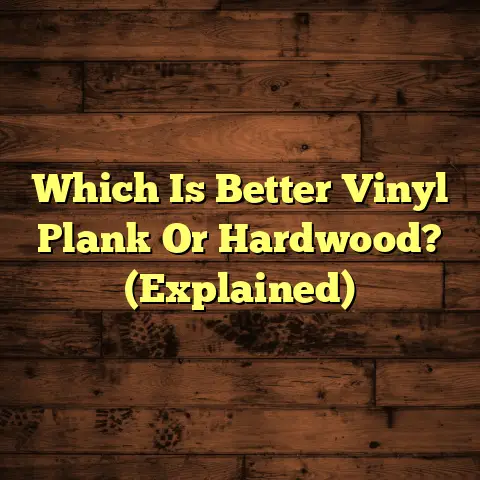Joist Replacement Cost? (3 Contractor Secrets!)
I’ve seen it all, from minor squeaks to major structural nightmares, and I’m here to share some insider secrets about joist replacement.
If you’re noticing bouncy floors, unexplained sags, or even that dreaded musty smell, you might be looking at joist issues.
And let’s be honest, that’s never good news.
But before you panic about the cost, let’s break down what you need to know, especially considering the climate you live in.
Because trust me, a joist replacement in sunny Arizona is a whole different ballgame than one in rainy Seattle!
Introduction: Addressing
Climate-Specific Needs
Think about it: your flooring system is the unsung hero of your home. It’s what you walk on, what your furniture sits on, and what keeps you separated from the crawl space or basement.
But what’s under the flooring is just as important – the joists.
And those joists are constantly battling the elements.
In areas with heavy rainfall like the Pacific Northwest, moisture is the enemy.
Wood rot, mold, and mildew can wreak havoc on joists if they’re not properly protected.
That means you might need to invest in pressure-treated lumber or even composite materials that are resistant to water damage.
On the other hand, if you’re in a dry climate like the Southwest, the concern shifts to extreme heat and potential for wood to dry out and crack.
You might need to think about proper ventilation to prevent excessive dryness and consider materials that are less prone to warping.
And don’t even get me started on coastal regions with salty air!
That salt can corrode metal fasteners and even weaken wood over time.
The bottom line?
Your climate plays a HUGE role in the longevity of your joists and, therefore, the cost of replacing them.
That’s why I’m here to give you the inside scoop on how to navigate these challenges and make smart decisions.
Section 1: Understanding Joists
and Their Role in Flooring Systems
So, what exactly are joists?
Simply put, joists are horizontal structural members that support your floors.
They’re typically made of wood, but you can also find them in steel or engineered materials like I-joists and trusses.
Think of them as the bones of your flooring system.
They span the distance between walls or beams, providing a stable surface for your subfloor (that layer of plywood or OSB you see underneath your carpet, tile, or hardwood).
Without joists, your floors would be, well, non-existent!
The spacing between joists is also crucial.
Typically, they’re spaced 12, 16, or 24 inches apart, depending on the load they need to support and the type of flooring you have.
Closer spacing generally means a stronger, stiffer floor.
Now, let’s talk about the different types of joists:
-
Wood Joists: These are the most common type, typically made from lumber like fir, pine, or spruce. They’re relatively inexpensive and easy to work with, but they’re also susceptible to moisture damage, rot, and insect infestation.
-
Steel Joists: Steel joists are stronger and more durable than wood joists, making them a good choice for commercial buildings or areas with heavy loads. However, they’re also more expensive and require specialized tools and skills to install.
-
Engineered Joists (I-Joists and Trusses): These are manufactured joists made from engineered wood products. They’re lightweight, strong, and resistant to warping and twisting. I-joists have a characteristic “I” shape, while trusses are made from a network of interconnected members.
How do joists interact with other flooring components?
Well, they’re all part of a team!
The joists support the subfloor, which in turn supports the finished flooring (carpet, tile, hardwood, etc.).
The subfloor is typically attached to the joists with nails or screws.
Any issues with the joists can affect the entire flooring system.
For example, if joists are sagging or rotting, it can cause the subfloor to become uneven, leading to squeaky floors, cracked tiles, or warped hardwood.
And as we discussed earlier, climate plays a huge role in how well your joists perform.
Moisture, temperature fluctuations, and even sunlight can all impact their structural integrity.
That’s why it’s so important to choose the right materials and construction methods for your specific climate.
Section 2: Factors Influencing
Joist Replacement Costs
Alright, let’s get down to the nitty-gritty: how much does it really cost to replace joists?
Unfortunately, there’s no one-size-fits-all answer.
The cost can vary widely depending on a number of factors.
Think of it as a recipe – each ingredient (factor) contributes to the final dish (cost).
Here are the key ingredients:
-
Material Selection: This is a big one. The type of joist material you choose will significantly impact the price. As a ballpark, you can expect to pay:
- Wood Joists: \$3 – \$7 per linear foot
- Steel Joists: \$8 – \$15 per linear foot
- Engineered Joists (I-Joists): \$5 – \$12 per linear foot
These prices are estimates and can vary based on lumber prices, steel prices, and the specific brand and grade of the material.
For example, pressure-treated lumber, which is essential in damp climates, will cost more than untreated lumber.
And if you’re dealing with saltwater exposure, you might need to consider even more expensive, corrosion-resistant materials.
-
Labor Costs: Labor rates can vary wildly depending on your geographic location and the experience of the contractor.
In general, you can expect to pay anywhere from \$50 to \$150 per hour for a qualified contractor.
Some contractors charge by the project, while others charge by the hour.
Be sure to get multiple quotes and ask for a detailed breakdown of the labor costs involved.
Also, keep in mind that labor costs can be higher in areas with a high cost of living.
According to HomeAdvisor, the national average for labor costs associated with structural repairs, which often includes joist work, ranges from \$4,000 to \$12,000.
(Source: HomeAdvisor)
This is a broad range, but it gives you an idea of the potential expense.
-
Project Complexity: This is where things can get tricky. The condition of your existing joists, the accessibility of the site, and the need for additional repairs can all influence the cost.
For example, if your joists are severely rotted or infested with termites, the contractor will need to remove and dispose of the old materials, which can add to the cost.
If the joists are difficult to access (e.g., in a tight crawl space), it will take longer to do the work, which will also increase the labor costs.
And if you need to make additional repairs to the subfloor, walls, or foundation, that will add even more to the overall expense.
-
Permitting and Inspections: Don’t forget about the paperwork! Most municipalities require permits for structural repairs, and you’ll likely need to have the work inspected to ensure it meets local building codes.
Permit fees can range from \$50 to \$500 or more, depending on the scope of the project and the location.
Inspection fees are typically lower, but they’re still an added expense.
In some areas, especially those prone to natural disasters like hurricanes or earthquakes, building codes are stricter, and you might need to meet additional requirements, which can increase the cost.
-
Disposal Fees: Getting rid of old, damaged joists isn’t free. Disposal fees at landfills or recycling centers can add up, especially if you have a large number of joists to remove.
These fees vary by location and the volume of material.
-
Climate-Specific Considerations: I can’t stress this enough! In wet climates, you might need to invest in moisture barriers, improved ventilation, or specialized treatments to prevent future problems.
In cold climates, you might need to add insulation to improve thermal performance.
And in coastal areas, you might need to use corrosion-resistant fasteners and materials.
All of these climate-specific considerations will add to the overall cost of the project.
Section 3: The Three Contractor
Secrets to Lowering Joist
Replacement Costs
Okay, so now you know what can drive up the cost of joist replacement.
But what can you do to lower the cost?
That’s where my three contractor secrets come in!
-
Secret #1: Choose the Right Time for Replacement
Timing is everything! Just like you might find better deals on flights or hotels during the off-season, you can often save money on contractor work by scheduling your project during slower periods.
Many contractors are less busy in the late fall or early winter, after the summer rush has subsided.
You might be able to negotiate a better rate or get a faster turnaround time.
But more importantly, consider your local climate. In rainy areas, it’s best to avoid doing joist replacement during the wettest months, as this can complicate the work and potentially lead to moisture damage.
In hot climates, avoid the peak of summer, when contractors are often booked solid and labor costs may be higher.
Ideally, aim for a dry, mild period when the weather is stable and contractors are more available.
-
Secret #2: Invest in Quality Materials
I know it’s tempting to save money by going with the cheapest materials, but trust me, it’s often a false economy.
Investing in high-quality, climate-appropriate materials will save you money in the long run by reducing the need for future repairs.
For example, pressure-treated lumber might cost more upfront, but it will resist rot and insect infestation, extending the life of your joists.
Similarly, engineered joists might be more expensive than traditional wood joists, but they’re stronger, more stable, and less prone to warping.
Think of it as an investment in your home’s long-term health.
Here’s a quick comparison:
Material Upfront Cost Longevity (Typical) Climate Suitability Untreated Lumber Lower 10-20 years Dry climates, well-ventilated areas Pressure-Treated Moderate 30-50 years Wet climates, areas prone to moisture Engineered Joists Higher 50+ years All climates, especially areas with long spans Steel Joists Highest 75+ years Commercial buildings, areas with heavy loads, any climate As you can see, the upfront cost is just one piece of the puzzle.
Consider the longevity and climate suitability of each material before making a decision.
-
Secret #3: Work with Experienced Contractors
This is perhaps the most important secret of all.
Hiring a contractor with experience in your specific climate zone is crucial.
A knowledgeable contractor will understand the local building codes, material recommendations, and cost-saving strategies that can ultimately reduce your replacement costs.
They’ll also be able to identify potential problems early on and recommend solutions that are tailored to your specific situation.
Don’t be afraid to ask potential contractors about their experience with joist replacement in your area.
Ask for references and check online reviews.
A good contractor will be transparent about their pricing and willing to answer all of your questions.
They should also be licensed and insured, which protects you in case of accidents or damage.
According to a survey by the National Association of Home Builders (NAHB), homeowners who hire licensed contractors are more satisfied with the results of their projects.
(Source: NAHB)
So, do your homework and choose wisely!
Section 4: Detailed Cost Breakdown
Let’s dive into a more detailed cost breakdown. Remember, these are just averages, and your actual costs may vary.
Material Costs (per linear foot):
- Wood Joists (Fir, Pine, Spruce): \$3 – \$7
- Pressure-Treated Lumber: \$5 – \$10
- Engineered Joists (I-Joists): \$5 – \$12
- Steel Joists: \$8 – \$15
Labor Costs (per hour):
- General Contractor: \$50 – \$150
- Specialized Carpenter: \$75 – \$200
Other Potential Costs:
- Permit Fees: \$50 – \$500+
- Inspection Fees: \$50 – \$200
- Disposal Fees: \$50 – \$300 (depending on volume)
- Moisture Barrier Installation: \$1 – \$3 per square foot
- Insulation Installation: \$1 – \$5 per square foot
- Subfloor Repair/Replacement: \$2 – \$5 per square foot
Example Scenario:
Let’s say you need to replace 20 joists, each 12 feet long, in a 200-square-foot area. You choose pressure-treated lumber and hire a contractor at \$100 per hour.
- Material Cost: 20 joists x 12 feet x \$7/foot (average) = \$1680
- Labor Cost: Assuming 40 hours of labor = \$4000
- Permit & Inspection: \$300 (estimated)
- Disposal Fees: \$150 (estimated)
Total Estimated Cost: \$6130
Hidden Costs to Watch Out For:
- Unexpected Damage: Once the contractor starts removing the old joists, they might discover additional damage to the subfloor, walls, or foundation. Be prepared for potential change orders.
- Asbestos or Lead Abatement: If your home was built before the 1980s, there’s a chance that asbestos or lead-based paint could be present. Abatement can add significant costs.
- Moisture Problems: If you live in a humid climate, you might need to invest in additional moisture barriers or dehumidifiers to prevent future problems.
- Unforeseen Code Requirements: Building codes can change over time. You might need to bring your flooring system up to current code, which can add to the expense.
Section 5: Case Studies
Let’s look at a few real-world examples to illustrate how climate and other factors can impact joist replacement costs:
Case Study 1: Seattle, Washington (Wet Climate)
- Challenge: A homeowner in Seattle noticed sagging floors and a musty smell in their kitchen. Upon inspection, it was discovered that several joists were severely rotted due to moisture penetration.
- Solution: The homeowner opted for pressure-treated lumber for the replacement joists and also invested in a vapor barrier and improved ventilation in the crawl space.
- Cost Impact: The cost was higher than average due to the need for moisture-resistant materials and the extra labor involved in installing the vapor barrier and improving ventilation.
Case Study 2: Phoenix, Arizona (Dry Climate)
- Challenge: A homeowner in Phoenix noticed cracking and warping in their hardwood floors. Upon inspection, it was discovered that the joists were excessively dry and brittle due to the arid climate.
- Solution: The homeowner opted for engineered joists, which are less prone to warping than traditional wood joists. They also installed a whole-house humidifier to maintain a more consistent humidity level.
- Cost Impact: The cost was higher than average due to the use of engineered joists and the installation of the humidifier.
Case Study 3: Miami, Florida (Coastal Climate)
- Challenge: A homeowner in Miami noticed corrosion on the metal fasteners holding their joists together. Upon inspection, it was discovered that the saltwater air was causing the fasteners to rust and weaken.
- Solution: The homeowner opted for stainless steel fasteners and also applied a corrosion-resistant coating to the joists.
- Cost Impact: The cost was higher than average due to the use of stainless steel fasteners and the application of the corrosion-resistant coating.
Conclusion
Replacing joists can feel like a daunting project, but with the right knowledge and planning, you can navigate the process successfully.
Remember the three contractor secrets:
- Choose the Right Time: Consider the season and your local climate.
- Invest in Quality Materials: Don’t skimp on materials that will last.
- Work with Experienced Contractors: Find someone who knows your area and its challenges.
By taking these factors into account, you can make informed decisions, control your costs, and ensure that your floors are solid and stable for years to come. Good luck!





